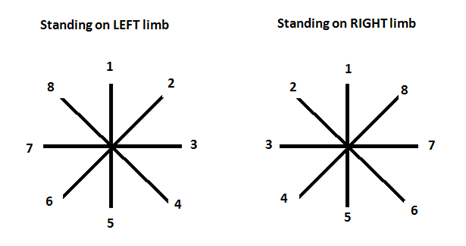Star Excursion Balance Test
Original Editor - Rachael Lowe
Top Contributors - Dieter Schuddinck, Evan Thomas, Sheik Abdul Khadir, Kim Jackson, Abbey Wright, Admin, Khloud Shreif, Heba El Saeid, Rachael Lowe, Simisola Ajeyalemi, Rucha Gadgil, Wanda van Niekerk, Lucinda hampton, 127.0.0.1, Tony Lowe, Scott Buxton, Naomi O'Reilly and WikiSysop
Introduction[edit | edit source]
The Star Excursion Balance Test (SEBT) is a dynamic test that requires strength, flexibility, and proprioception. It is a measure of dynamic balance that provides a significant challenge to athletes and physically active individuals. The test can be used to assess physical performance, but can also be used to screen deficits in dynamic postural control due to musculoskeletal injuries (e.g. chronic ankle instability), to identify athletes at greater risk for lower extremity injury, as well as during the rehabilitation of orthopedic injuries in healthy active adults.[1][2]
The SEBT can also be used to compare balance ability among different sports and to assess physical performance. Research has suggested to use this test as a screening tool for sport participation as well as a post-rehabilitation test to ensure dynamic functional symmetry. It has also been shown that the performance of SEBT improves after training.[2]
It is important that the test captures the greatest amount of information with regards to instability in the shortest amount of time.[2]
Technique[edit | edit source]
Before the SEBT can be performed, a small amount of setup is required. Four strips of athletic tape will need to be cut to a length of 6-8 feet each. Two pieces will be used to form a ‘+’, with the other two being placed over top to form an ‘x’ so that a star shape is formed. It is important that all lines are separated from each other by a 45° angle.[3] The goal of the SEBT is to maintain single leg stance on one leg while reaching as far as possible with the contralateral leg [2].
The person performing the test must maintain a their balance on one leg, while using the other leg to reach as far as possible in 8 different directions. The person (standing on his/her left leg for example) must reach in 8 different positions, once in each of the following directions: anterior, anteromedial, medial, posteromedial, posterior, posterolateral, lateral and anterolateral.[3] The anterior, posteromedial and posterolateral directions appear to be important to identify individuals with chronic ankle instability and athletes at greater risk of lower extremity injury.[2]
When the person demonstrates a significantly decreased reach while standing on the injured limb compared to standing on the healthy limb, the Star Excursion Balance Test has highlighted his/her's loss of dynamic postural control.[3]
The test originally incorporated reaching in eight directions while standing on each foot, but factor analysis indicated that one reach direction in particular (posteromedial) was able to accurately identify individuals with chronic ankle instability as well as performing all eight directions.[2]
1. Anterior
2. Anteromedial
3. Medial
4. Posteromedial
5. Posterior
6. Posterolateral
7. Lateral
8. Anterolateral
There is a similar test to the SEBT, but only utilizes three directions, and is known as the 'Y-test'.
Evidence[edit | edit source]
There have been different studies that have investigated the evidence of the Star Excursion Balance Test. First, an overview of the reliability.
- According to Hertel, Miller, and Deneger (2000), the reliability of the SEBT ranges between r = 0.85-0.96[1]
- According to Plisky et al (2006), the reliability of this test ranges between 0.82-0.87 and scores 0.99 for the measurement of limb length[4]
- In two other studies, Kinezey et al (1998) and Hardy et al (2008), the reliability of the SEBT was determined as having intra-class correlation coefficients ranging from 0.67-0.87[5][6]
- Chaiwanichsiri et al (2005) concluded that the Star Excursion Balance training was more effective than a conventional therapy program in improving functional stability of a sprained ankle[7]
- Plisky et al (2009) concluded that the intra-rater reliability of the SEBT as being moderate to good (ICC 0.67- 0.97) and inter-rater reliability as being poor to good (0.35-0.93)[2]
The SEBT appears to be an effective means for determining reach deficits both between and within subjects with unilateral chronic ankle instability.[3] It can also be used to determine deficits and asymmetries in individuals, as well to assist in the return to play decision-making process.[2]
To discuss the validity of this test in certain injured populations, such as patellofemoral pain syndrome, further research is still recommended.[3]
Recent Related Research (from Pubmed)[edit | edit source]
Failed to load RSS feed from http://www.ncbi.nlm.nih.gov/entrez/eutils/erss.cgi?rss_guid=1nWYA0Nnwr_wLFRLylDPsGnR5goOAWKrSs1eNlFCj3UqBDoQi5: Error parsing XML for RSS
References[edit | edit source]
- ↑ 1.0 1.1 Advanced fitness assessment and exercise prescription. Heyward V. Human kinetics, 6th edition: 303 (5)
- ↑ 2.0 2.1 2.2 2.3 2.4 2.5 2.6 2.7 The Reliability of an Instrumented Device for Measuring Components of the Star Excursion Balance Test. Plisky P et al. Am J Sports Phys Ther. 2009 May; 4(2): 92–99. (2B)
- ↑ 3.0 3.1 3.2 3.3 3.4 Efficacy of the Star Excursion Balance Tests in Detecting Reach Deficits in Subjects With Chronic Ankle Instability. Olmsted L., Caria C., Hertel J., Shultz S. Journal of Athletic Training 2002;37(4):501–506 (1B)
- ↑ Star Excursion Balance Test as a Predictor of Lower Extremity Injury in High School Basketball Players. Plisky P., Rauh M., Kaminski T., Underwood F. Journal of Orthopaedic and Sports Physical Therapy 2006; 36 (12) (1B)
- ↑ The reliability of the star-excursion test in assessing dynamic balance. Kinzey SJ., Armstrong CW., et al. J Orthop Sports Phys Ther. 1998;27(5): 365-360 (1B)
- ↑ Prophylactic Ankle Braces and SEBT Measures in Healthy Volunteers. Hardy L., Huxel K., Brucker J., Nesser T. Journal of Athletic Training 2008;43(4):347–351 (2C)
- ↑ Star Excursion Balance Training : Effects on Ankle Functional Stability after Ankle Sprain. Chaiwanichsiri D., Lorprayoon E., Noomanoch L. J Med Assoc Thai 2005; 88(4): 90-94 (1B)







